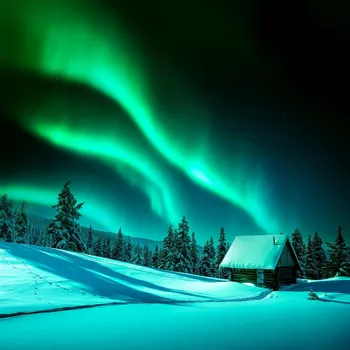Unraveling Weather Mysteries: Simple Explanations for 7 Phenomena! Dive in to demystify nature's wonders!
Folks, the weather! It's the one thing we all love to complain about, right? Whether it's the scorching
heat, the relentless monsoons, or that unexpected cold snap, it affects our daily lives in so many ways. But have you ever stopped to wonder what actually causes these weather events?

It's not magic, you know! It's all good ol' science at work. Today, we're going to break down seven common weather phenomena in a way that even your grandma can understand. Chalo, let's begin!
Rain formation: from evaporation to condensation, vital for nature
First up, we have the humble rain. Now, we all know it falls from the sky, but how does it actually become rain? Well, it all starts with evaporation. The sun heats up water from lakes, rivers, and even puddles, turning it into water vapour which rises up into the atmosphere.
As the water vapour goes higher, it cools down. This cooling causes the water vapour to condense around tiny particles in the air, like dust or pollen. Think about it like this: the water vapour needs something to hold on to. These little droplets then join together, becoming bigger and bigger.
Once they get heavy enough, gravity pulls them back down to earth as rain! See, simple as chai! Understanding this process helps us appreciate why rain is so crucial for our crops and our water supply. It's all part of the big water cycle that keeps our planet going.
So next time you see rain, remember it's not just water falling, it's water completing its journey. This journey, driven by the sun and aided by tiny particles, is a beautiful example of nature's engineering. We should always value every drop of it.
Proper water conservation is equally important to protect it from wastage. Let us think about the future and save water.
Fog in North India during winter: driving tips and challenges
Next, let's talk about fog. Especially those of us in Delhi or other north Indian cities know all about fog during the winter months. It can be so thick you can barely see the car in front of you! Fog is basically a cloud that forms near the ground.
It happens when the air near the ground cools down and the water vapour in the air condenses into tiny water droplets just like in clouds. But instead of being high up in the sky, these droplets are floating right there at ground level, reducing visibility.
Fog often forms on clear, calm nights when the ground cools quickly, allowing the air above it to cool as well. Sometimes, you can see fog lifting as the sun warms the air, causing the water droplets to evaporate. Dealing with fog mostly involves driving carefully and patiently.
It's important to use your fog lights, drive slowly, and keep a safe distance from the vehicle in front of you. Apart from the difficulty in transport, it also causes problems in other commercial activities. Therefore, we should learn to deal with it efficiently.
Sunshine drives weather patterns and affects health and mood
Now, what about sunshine? It might seem simple enough – the sun shines, it gets warm. But there's a lot more to it than that. The sun emits all sorts of energy wavelengths, not just the visible light we see. Some of the sun's energy is reflected back into space by the Earth's atmosphere and clouds.

But a lot of it reaches the surface, warming the land, the oceans, and the air. This warmth is what drives all sorts of weather patterns. For example, warm air rises, creating areas of low pressure. This area is then filled by cooler air which creates winds.
Also, the angle at which the sun's rays hit the Earth also affects the temperature. That's why it's warmer at the equator, where the sun shines more directly, and colder at the poles, where the sun's rays are more slanted. Sunshine duration also affects our moods and well-being.
Exposure to sunlight helps our bodies produce vitamin D, which is essential for healthy bones and a strong immune system. But, it's also important to protect ourselves from too much sun exposure by wearing sunscreen, especially during the peak hours of the day.
Wind is caused by pressure differences due to sun's heating and Earth's rotation
Let's explore the concept of wind. Wind is simply air moving from one place to another. But what causes the air to move in the first place? It's all about pressure differences. Air moves from areas of high pressure to areas of low pressure.

Think of it like a balloon: when you pop it, all the air rushes out from the high pressure inside the balloon to the lower pressure outside. The bigger the difference in pressure, the stronger the wind will be. These pressure differences are created by the sun's uneven heating of the Earth.
Warm air rises, creating low pressure, while cool air sinks, creating high pressure. The Earth's rotation also affects wind direction. This is known as the Coriolis effect. This effect affects large-scale weather patterns, such as the trade winds and the jet stream.
Wind is important for many things. It helps spread heat around the planet, disperse pollution, and even generate electricity through wind turbines. It also plays a crucial role in weather forecasting.
By understanding wind patterns, meteorologists can predict where storms are likely to move and how strong they will be.
Hailstorms form in cumulonimbus clouds, causing damage with large hailstones
Hailstorms, those icy pellets plummeting from the sky during a thunderstorm, can be fascinating and destructive. Hail forms within cumulonimbus clouds, the towering giants responsible for thunderstorms.
Strong updrafts within these clouds carry raindrops high into the atmosphere where temperatures are below freezing. These supercooled water droplets freeze onto small ice crystals.
As these ice pellets are tossed around in the cloud by the updrafts, they gather more and more layers of ice, growing larger and heavier. Eventually, the hail becomes too heavy for the updrafts to support, and it falls to the ground.
The size of hailstones can vary from small pea-sized pellets to large stones the size of golf balls or even larger. Large hailstones can cause significant damage to crops, vehicles, and buildings.
Hailstorms are often associated with severe thunderstorms and can sometimes be accompanied by strong winds, heavy rain, and even tornadoes. After a hailstorm, it's important to assess and repair any damage to your property.
Thunderstorms: powerful weather events with rain, lightning, thunder, hail, and tornadoes
Finally, let's discuss thunderstorms. Thunderstorms are intense weather events that can bring heavy rain, lightning, thunder, and sometimes hail or tornadoes. They form when warm, moist air rises rapidly into the atmosphere, creating an unstable air mass.
As the warm air rises, it cools and condenses, forming cumulonimbus clouds. These clouds can grow to enormous heights, spanning several kilometers. Inside the thunderstorm cloud, water droplets and ice crystals collide, creating electrical charges.
These charges separate, with positive charges accumulating at the top of the cloud and negative charges accumulating at the bottom.
When the electrical charge becomes strong enough, it discharges as lightning, which heats the air around it, causing it to expand rapidly and create the sound we hear as thunder. Thunderstorms can be dangerous, but they also play a vital role in the Earth's atmosphere.
They help to redistribute heat and moisture, and they can also generate nitrogen that is essential for plant growth.
AI Generated Content. Glance/InMobi shall have no liability for the content















